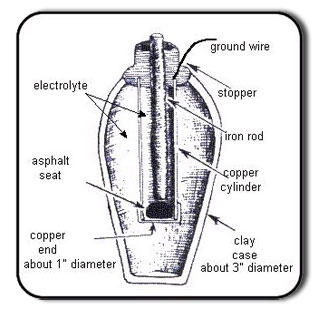11 Modern Technologies That Are Way Older Than You Think

For a long time, we've been able to pride ourselves on the fact that we're smarter than our primitive ancestors. Sure, they made fire and the wheel and invented language, or whatever, but we brought technology.
Turns out a lot of our most technologically sophisticated inventions were already invented, which does nothing but remind us how useless we are.
iPod

Believed to have been invented in...
In 2001, if you are a die hard Mac fan. Or 1997, if you are aware cheaper MP3 players existed before Steve Jobs figured out people would pay twice as much to hear their pirated songs on the bus if the MP3 player looked like the bastard son of Eve from Wall-EActually Invented in...
In 1979, Kane Kramer and his friend, James Campbell, came up with the idea of a portable music player the size of a cigarette box. The music player baptized as the IXI System stored music digitally in a chip and had a display screen and buttons to navigate it.

They even built five prototypes they showed potential investors. Wow! That sounds amazing! So they sold it, became gazillionaires and everybody listened to ABBA songs they downloaded with their Ataris, right? Well, no, obviously not.
The IXI had one big problem: It only had enough memory for three and a half minutes of music, which does screw you up if you had your heart set on carrying "In-A-Gadda-Da-Vida" anywhere you went. And how were you supposed to get your music files back in the decades before Napster?

Since almost nobody had computers in those days, Kramer suggested putting terminals in music stores, connected via telephone with a central music server so users could buy and download their music at the store. Keep in mind we're talking about 1979 phone modems, which means Kramer's idea also involved people bringing their own tent and enough food for camping for two months while they downloaded "Funky Town."
The Automobile

Believed to have been invented in...
Late 19th century or early 20th century, or whatever the hell that World of Motion ride at EPCOT said.
Actually Invented in...
A French inventor named Nicolas Joseph Cugnot built one, back before the American Revolution.
Back when most people were blaming their diseases on fairies and the evil eye, Cugnot had one great idea: a horse carriage minus the stupid, smelly horse. In 1769, he finally finished his horseless carriage; a steam-engine-powered automobile that looked like a steampunk Big Wheel.

It could carry four tons while traveling at the break-neck speed of two and a half miles per hour (people had really weak necks in those days).
Why did we never read about Napoleon's mechanized, steam-powered army trampling England under their godless robotic wheels? Well, the inventions had problems. While testing his vehicle in 1771, Cugnot lost control and discovered the unique sensation we've come to know as "crashing into a brick wall." You might think that you could laugh off such a crash at five miles an hour, but try it while sitting in one of these bastards.

Despite being an undeniably revolutionary invention, it was still slow, heavy and horrible to drive. Cugnot ran out of money to improve his invention, and while the French government was interested in continuing with the idea, a little uprising of the people called the French Revolution put an end to that.
Cugnot escaped to Belgium where he lived in poverty. Fun fact: There were about 600-700 million people on earth when Cugnot was born. That's also how many cars there are now.
Heat Rays

Believed to have been invented in...
In 2007, headlines blared that the US military had unveiled an unstoppable weapon in the war against comfortable temperatures. The Active Denial System looks like a car that can catch scrambled porn channel signals, but its purpose is far more sinister and less useful: It shoots a beam that heats people's skin to an uncomfortable 122 degrees Fahrenheit.
That sounds low, but remember the idea is to disperse crowds, not turn people into ash, War of the Worlds-style.
Actually Invented in...

"Dammit! The naked guy walked into the picture again!"
Well you could go all the way back to before 400 BC, when polished surfaces could be used to focus sunlight to ignite fires or cauterize wounds. But heat rays only got interesting in 212 BC when Archimedes supposedly built a heat ray to burn down enemy ships to defend the city of Syracuse.
As our commenters will be glad to point out, many scientists consider Archimedes' heat ray a myth, including the guys from Mythbusters. But some equally smart people disagree.

Doctor Ioannis Sakkas, a Greek engineer with the name of a Star Trek villain, conducted experiments in 1973 to prove that Archimedes crazy ass death ray was possible. Instead of using one giant mirror like others who tried and failed, Sakkas used 50 human sized bronze mirrors that, when reflecting light unto the same small wooden boat, managed to ignite it in a short time.

And as any scientist can tell you, when confronted with two possible theories, the scientific method dictates that we must go with the one that is awesome.
The Computer

Believed to have been invented in...
Some time around World War II, by Alan Turing or by Konrad Zuse, depending on whether you ask Alan Turing or Konrad Zuse.
Actually Invented in...
Some time around 1833. Charles Babbage was a man who hated errors. Mistakes and mathematical untidiness burned his ass so much he decided to build a ludicrously complex machine just to stop idiots from not doing math right.

In 1822, Babbage proposed the idea of building a mechanical calculator to tabulate polynomial functions. The British government, or those officials who didn't fall asleep while Babbage explained the idea, gave him a huge bag of money with a pound sign painted on it and sent him to work on it. 10 years later they finally figured out Babbage was never going to finish the machine because he was an insufferable ass who pissed off everyone who tried to help him.
By that time Charles had already moved on to bigger things. He looked at his awesome polynomial functions tabulator and thought "You know what's more rad than polynomial functions? A machine you could program to do all different kinds of math!" And so he conceived the Analytical Engine. And he built it and then laid back and played Grand Theft Horse Carriage: Manchester happily ever after, or he would have if he had ever managed to finish a damn thing in his life.

He asked the British Association for the Advancement of Science for funds, and was promptly denied, since all of their money was presumably tied up with a guy who said he could cure the evil eye with some leeches or something.
The last version of the machine read programs and data from punch cards and had a memory capable of storing 1,000 numbers with 50 decimal digits each, which roughly translates to 20.7 Kb. Only a partial model was finished, when Babbage died in 1878 while still trying to perfect the design.
As a side note, Babbage's invention lead to the invention of a new career. Augusta Ada King, countess of Lovelace, created the first program for the never finished machine (a program to calculate Bernoulli numbers) becoming the world's first programmer.

Programmers should still be required to wear this.
Submarines

Believed to have been invented in...
Most people will either tell you World War I or 1870, the year Jules Verne predicted the invention in Twenty Thousand Leagues Under the Sea.
Actually Invented in...
The first description of a submersible ship that did not involve magic, witches or copious amounts of booze actually came in 1580 from William Bourne, an English inn keeper who designed a way for ships to decrease and increase volume to change density. Since Bourne was an inn keeper and preferred to breathe air, the world had to wait until 1623 for the first submarine to actually be built. Dutchman Cornelius Drebbel's submarine was propelled by 12 oarsmen and could sink to a depth of 15 feet.

Since people like to beat the crap out of each other so much, the world only had to wait another 30 years for the first war submarine. Tired of Van Damme being its only weapon, Belgium built a submarine for war.

The good old US of A then got in on the action, trying to use submarines in the revolutionary war. In 1776 Ezra Lee piloted the Turtle, a submarine built by 16-year-old Yale alumni, David Bushnell. The Turtle's weapon was a drill to make holes in enemy ships and put time bombs into the holes. We can only guess patriot general Wile. E. Coyote came up with that one.

You apparently had to operate the drill with your dick.
Video Games

Believed to have been invented in...
1972, the year Pong and the Magnavox Odyssey came out.
Actually Invented in...
1948, when Thomas Goldsmith Jr., a professor of physics at Furman University, patented his horrendously badly named idea, the Cathode Ray Tube Amusement Device.

The Amusement Device was based off old military radar displays, which were just dots on a screen. They figured you could put some kind of overlay on the screen with pictures of aliens on it or whatever, and you'd have a rudimentary game where you could shoot projectiles at the bad guys. Despite being only kinda crappy, it was still too expensive to be marketable and only a few prototypes were ever built.
The second video game came out three years later. British electronics company Ferranti built the NIMROD, a computer designed to play one game and one game only, the classic game of NIM.

Go on, play NIM online so you can relive the forgotten golden age of video games: we'll wait.
Back? Yeah, that sucked; especially because the bastard computer keeps winning (obviously, it cheats!). Like all computers from those days, it was the size of Adam West's Bat-computer, and simulated a game that's played with 16 match sticks. So the first computer game was only useful if you were the world's greatest NIM player, or just extremely short on matchsticks.
The Automatic Door

Believed to have been invented in...
1954, by Dee Horton and Lew Hewitt.
These two Texans designed the first automatic door after noticing how strong winds would fuck with people's door opening abilities. The pair got to work on their product and, before long, people across the world were walking up to automatic doors, hesitating, thinking "fuck, is...is it broke?," continuing, halting abruptly, shielding their face with their hands and then flinching, humiliated as the door opened with perfect comedic timing.

Horton and Hewitt went on to found Horton Automatics, one of the biggest sellers of automatic doors today, with a massive range of clients including McDonald's and Tim Horton's Donuts (Nepotism?).
Actually invented in...
Around 50 BC, by Hero of Alexandria.
Fucktasticly named Hero was a Greek engineer, mathematician, inventor, teacher and overachiever who is believed to have lived somewhere around the second century. He is credited with numerous inventions, but his most celebrated was the aeolipile, which is not a type of airborne haemorrhoid, but an early steam engine.

The invention was used to spice up religious ceremonies with some special effects. The invention consisted of an alter, to be placed in front of some large, heavy temple doors, and all manners of pullies, buckets, fire and water. It was kind of like Mouse Trap, but instead of catching mice it made the masses think the breath of God had opened the doors.
As a companion piece, Hero designed a similar device that would be used to create the sound of a trumpet when the temple doors opened, because everyone knows God has an invisible trumpet follow him everywhere he goes.
The Flamethrower

Believed to have been invented in...
1901, by the Germans.
Richard Fiedler created the "flammenwerfer" for the German army, just in time to capitalize on the 20th century's demand for horrible, skin-melting weapons. But it wasn't until the Second World War that the US invented a flamethrower that could fire continuous streams of burning fuel. These had such a damaging psychological effect on German soldiers that flamethrower operators who were captured by the Nazi's would be summarily executed on the spot.
The US army discontinued the use of the weapons when the realized that enemies running screaming while engulfed in flame doesn't really do much for the whole "winning hearts and minds" thing.

Actually invented in...
The 7th Century AD, by the Greeks.
Around 672 AD, a Syrian refugee and engineer invented what would come to be known as Greek Fire. This was a secret formula invented by the Byzantine Greeks and used in naval battle to burn ships, and in land battles to burn people.

Initially, it was fired from ships through a hand pump, but later a more mobile version that fired a stream of flames was developed. Greek Fire could not be put out with water alone, would stick to surfaces and ignited on contact. For this reason it has been compared to napalm, although no one liked the smell of Greek Fire in the morning, because due to its volatile and unpredictable nature, if you smelt it, you were probably on fire.

Batteries

Believed to have been invented in...
1800, by Italian Alessandro Volta.
Nine years earlier fellow Italian Luigi Galvani attached two pieces of metal to a dead frog's leg and noticed that when he did, the leg twitched, thus discovering that animals generate electricity and, at the same time, establishing the historical animosity between experimental scientists and frogs.

"Science: 1. Frogs: 0."
Galvani, though, thought that living things and living things alone were the source of all electricity, a touchingly idealistic notion that would have made for some horrific power generators. Alessandro Volta, on the other hand, substituted frogs with cardboard soaked in salt water, producing what was thought to be the world's first battery.
Actually invented in...

In 1938, German archaeologist Wilhelm Konig (who died a few years later in a face melting Ark of the Covenant related accident) discovered a number of clay jars that would come to be known as the Baghdad Batteries. The jars have an asphalt stopper and, sticking through it, an iron rod surrounded by a copper cylinder. Tests revealed the presence of an acidic substance similar to vinegar and when replicas were made and filled with such a substance they produced between 0.8 and 2 volts.
The discovery of a working battery from 200 BC raised a whole lot more questions than it answered. Were there a lot of devices that required batteries back then? Did everyone just respond to the inventor with, "Nice going dipshit, a battery is exactly what we need to feed our families."
Some scientists propose that they were used to relieve pain while other scientists point out that electric stimulation would be ineffective when compared to painkillers available at the time such as heroin opiate and cannabis; who wants an electric shock when you could be chasing the dragon?

The most plausible explanation is that they were used to electrically graft silver onto gold, a method that is still practiced in Iraq today. Another is that they were placed into statues of gods to simulate the religious experience of "HOLY CRAP GOD JUST FREAKING SHOCKED ME! WHAT A DICK!"
Vending Machines

Believed to have been invented in...
The early 1880s.
Coin operated vending machines were first introduced in London to dispense post cards and books.
America protested, "But you can't get fat on post cards or books," so the Thomas Adams Gum Company installed machines that dispensed gum and snacks on the New York subway. The invention soon caught on and over the decades has provided mankind with their most desired items; cigarettes, candy and schoolgirls' used panties.

Actually invented in...
Between 215 BC and 100 AD by, you guessed it, Hero of Alexandria.

The purpose of this first vending machine was to dispense holy water in the temples of Egypt. The device worked in the same way as a modern vending machine; worshipers would put coins in the top and it would dispense a measured amount of holy water for washing. At the end of the day, the machine would be emptied of coins and topped off with blessed water.
And we have to assume that more than once a day, some ancient worshiper dropped his coins in, got nothing in return, and then immediately rocked the machine back and forth while cursing under his breath. At least we've ironed that little wrinkle out.
The Dildo

Believed to have been invented in...
1966, by Ted Marche.
The 1960s were a volatile time for the world. In the US, students were being shot and killed at anti-war rallies; in Britain, the Rolling Stone's were recording Street Fighting Man; in France, there was rioting in Paris; while in California, Ted Marche was designing things for women to stick in their vaginas.
One night in 1966, middle-aged ventriloquist (that's right, ventriloquist) Marche sat down at the family dinner table and began carving a six inch cock. It was the beginning of something beautiful, sort of creepy and incredibly lucrative; Marche went on to build a million dollar industry out of his invention. By 1976, Marche Manufacturing (Cracked would have went with Ventriloquist Cock, Inc.) had sold nearly five million dildos. None of these though sold in Texas, where they passed a law banning their sale. For more information on the state of Texas and their fear of dildos, why not read this 33 page essay by Phoebe Godfrey Ph.D. of Texas A&M on Texan dildos, the last page of which is a "dildo release form."

Actually invented in...
In 2005, a group of archaeologists discovered 13 fragments of siltstone at a site in Germany. Upon unearthing the 14th, they put the pieces together and realized that their great archaeological discovery was not, in fact, an ancient Greek computer or a primitive Mesopotamian battery, but a massive dildo. Like Isaac Newton and gravity, Einstein and relativity and Columbus and America, their names would forever be associated with their discovery: really, really old cock.

The dildo is 20 centimeters long, three centimeters wide and dates to the Ice Age, where women, judging by the objects size, apparently had a "massive capacity". Professor Nicholas Conard, a member of the team that, ahem, examined the dildo, spoke about their find saying: "In addition to being a symbolic representation of male genitalia... It's highly polished." Indeed.
While they may have discovered the oldest known sex toy, they didn't discover the only one. It seems that as long as human beings have had holes, we've invented things to put in those holes. Sex toys were commonly used in ancient Greece and according to always reliable source Wikipedia, archaeologists regularly discover ancient dildos but are reluctant to label them as such, probably because they don't want to be known as "that guy that keeps discovering dildos--you know, Indiana Dongs."
To see more ways we're inferior to our ancestors, check out 6 Insane Discoveries That Science Can't Explain. Or find out about some puzzingly dumb mysteries they left behind for us that we do (or at least should) have answers for, in 6 Famous Unsolved Mysteries (With Really Obvious Solutions).
And check out Cracked.com's Top Picks, which may or may not have been innovated by Hero.